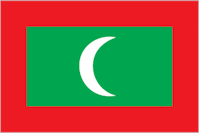Maldives - Introduction
 The US Central Intelligence Agency notes that "the Maldives National Defense Force (MNDF), with its small size and with little serviceable equipment, is inadequate to prevent external aggression and is primarily tasked to reinforce the Maldives Police Service (MPS) and ensure security in the exclusive economic zone." The authoritative Military Balance is the IISS annual assessment of the military capabilities and defence economics of 171 countries worldwide. Maldives did not make the list.
The US Central Intelligence Agency notes that "the Maldives National Defense Force (MNDF), with its small size and with little serviceable equipment, is inadequate to prevent external aggression and is primarily tasked to reinforce the Maldives Police Service (MPS) and ensure security in the exclusive economic zone." The authoritative Military Balance is the IISS annual assessment of the military capabilities and defence economics of 171 countries worldwide. Maldives did not make the list.
There had been a growing trend in Islamic conservatism since the advent of democracy and free speech. Opposition sources claim that over 350 Maldivian citizens have joined the ranks of the so-called Islamic State terror group. In per capita terms, no other country in the world had so many of its citizens affiliated with the outfit. In 2016 the government stated that of a population of about 350,000, the number of fighters was in the range of 40 to 50. Even after taking into account the number of family members who had accompanied these fighters, the total figure remains below 100. A report published in 2015 by the Kellogg Institute at the Northwestern University in the US concluded that the Maldives ranked second worldwide - behind Tunisia - in the number of IS foreign fighters to overall population.
Historically, the Maldives was an important crossroad in the Indian Ocean, hence Maldivian culture is a melting pot of various influences gathered from visitors who set foot there over the centuries. Influences of India, Sri Lanka, Arabia, Persia, Indonesia, Malaysia and Africa are evident in the unique culture of the Maldives. Maldivians have assimilated these influences over the years and created their own cultural identity like no other.
A proud history and rich culture evolved from the first settlers in the Maldives, who were seafarers from various parts of the world, traversing the oceans in ancient times. Since people from different parts of the world settled in the Maldives over the centuries, some of the traditions they brought with them remain in Maldivian culture. Some of the traditional drumming and dancing (known as ‘boduberu’) shows African influences, with rhythmic beating of drums and some songs in a language resembling that of East African countries.
As one would expect, there is a great South Asian influence in some of the music and dancing and particularly in the traditional food of the Maldives. This includes spicy curries using coconut milk and fish as the main staples and ‘roshi’ (a thin flatbread) as a popular accompaniment. Those who aren’t fans of curries will also find a range of world cuisine available including pasta, burgers, noodles and other home comforts. The resorts boast a wide variety of international cuisine, much of which is serious competition for the world’s top restaurants. Fresh ingredients are flown in daily or grown on the islands.
However, some of the South Asian customs especially with regard to women such as the Sub Continent’s tradition of secluding women from public view are not tenets of life here. In fact, women play a major role in society - not surprising considering the fact many Maldivian men spend the whole day out at sea fishing. Many of the country’s traditions are strongly related to the sea and the fact that life is dependent on the sea.
Traditional handicrafts include matt-weaving and beautiful lacquer-work, usually painted in black, red and yellow. Although these traditions are less commonplace today, there are still some talented craftsmen and women who make these (matts are weaved exclusively by women).
|
NEWSLETTER
|
| Join the GlobalSecurity.org mailing list |
|
|
|

